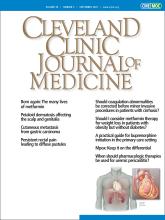
Repurposing of medications—getting US Food and Drug Administration (FDA) approval to use an old drug for a new indication—is not a new drug-development strategy, as I have discussed before1 and as we saw most recently during the COVID-19 pandemic. As physicians, we can prescribe FDA-approved drugs to individual patients off-label. But off-label use has drawbacks. Insurance companies need not cover the cost of the drug. We may place ourselves at increased legal risk as a result of any untoward drug-related event. The pharmaceutical company cannot actively condone or promote off-label use without risking great financial penalty. Without moving through the normal regulatory approval process, the drug will likely not undergo rigorous safety and efficacy testing in the targeted patient population. In addition, there is often much to be learned about drug-disease-patient interactions from a well-conducted clinical trial that will enhance clinical care, as opposed to relying only on anecdotal accumulated experiences.
Achieving FDA approval for a new drug is an arduous process, with the overwhelming majority of tested compounds falling by the wayside without approval due to safety or efficacy concerns. Previously approved drugs, however, have the advantage of already running the gauntlet of preclinical animal toxicology, teratology, and drug-distribution studies, clinical dose-range studies, and safety observation from phase 3 clinical trials—and perhaps also from postmarketing surveillance and anecdotal safety reports. Thus, they are unlikely to fail for unforeseen safety reasons, unless there is a safety signal unique to the intended disease-specific population, and adequate efficacy must still be demonstrated.
There are multiple reasons why a specific drug may be selected for formal repurposing. Sometimes, during the drug’s initial development, when the mass of collected data is analyzed, information is gleaned that suggests an unanticipated beneficial off-target effect (eg, on blood pressure or low-density lipoprotein cholesterol levels, or on weight). Sometimes the structures of FDA-approved drugs are analyzed to see if they can “fit” into a computer-generated image of a desired target receptor or target site of enzyme activity. And sometimes postapproval clinical use in the real world or in postmarketing studies reveals a desired off-target effect in treated patients: semaglutide, originally approved for diabetes mellitus, is now also approved for obesity, and baricitinib, approved for rheumatoid arthritis, is now also approved for alopecia areata and COVID-19. As Rodriguez et al2 discuss in this issue of the Journal, metformin, the initial go-to drug for most patients with type 2 diabetes, should also be considered as an initial and adjunctive treatment for obesity, based on clinical experience and on the results of a large randomized, placebo-controlled diabetes prevention trial.
The story of metformin is what my friend and medical podcaster Adam Brown would call a “ripping yarn”—a Britishism for a thrilling tale. When I was in training, metformin and its classmate phenformin were the answers to pharmacologic trivia and acid-base questions related to the development of lactic acidosis in patients with diabetes. I never anticipated the prominent role that metformin would ultimately play in the management of diabetes and, increasingly, in a number of other disorders. But the versatility of the drug was recognized long before the 20th century.
Since the Middle Ages, herbalists have used extracts from the plant French lilac (Galega officinalis, “goat’s rue”) to treat worm infections, epilepsy, plague, and conditions of “thirst and frequent urination” (aka diabetes). Substances isolated from the plant included several guanidines that were found to lower blood glucose levels, although some proved to have unacceptable toxicity. Galegine, one of the better-tolerated compounds, was studied in the 1920s and was shown to lower glucose slightly in normal volunteers, but more markedly in individuals with diabetes. With the discovery of insulin, research on these alternative compounds slowed. Several decades later, metformin (1,1-dimethylbiguanide hydrochloride) and other guanidines were tested in different clinical settings. During testing and use in treating influenza virus in the 1940s, metformin’s hypoglycemic effect was reconfirmed. (Note: Studies of metformin as an antiviral to treat COVID-19 were not without historical precedent.) French pharmacologist and physician Dr. Jean Sterne (1909–1997) laboriously investigated metformin’s hypoglycemic effects, leading to its registration in parts of Europe in 1957. Around the same time, the biguanide phenformin was developed in the United States. It was more potent than metformin, received FDA approval, and was heavily marketed. However, phenformin provoked lactic acidosis that was associated with a number of fatalities, which severely tarnished the biguanides, including metformin. Phenformin was ultimately removed from the US market in 1978.
Renewed interest in the hypoglycemic effects of metformin, which lacks phenformin’s propensity to elicit lactic acidosis, led to its FDA approval for type 2 diabetes. Then, several years later, it was shown to also reduce the frequency of cardiovascular events.
Metformin’s primary mechanism of action in lowering glucose is not entirely clear. It does not stimulate insulin release, but it has several demonstrated pharmacologic effects: it decreases gluconeogenesis in the liver, and it enhances insulin activity at least in part by stimulating glucose transport into skeletal myocytes. In what appears to be a concentration-dependent manner, metformin can affect mitochondrial function, reduce intracellular adenosine triphosphate, and ultimately increase the concentration of adenosine monophosphate-activated protein kinase (AMPK), a major sensor of energy stores and thus a modulator of several intracellular metabolic pathways and cellular functions. Increased AMPK can affect fat storage and decrease several transcription factors, including some that drive the synthesis of proinflammatory cytokines. Thus, it should be no surprise that metformin is being utilized and investigated in the treatment of polycystic ovary syndrome, fatty liver syndromes, rheumatoid arthritis, systemic lupus, and long COVID, as well as obesity.
Further study may provide even more lives for metformin.
- Copyright © 2023 The Cleveland Clinic Foundation. All Rights Reserved.






